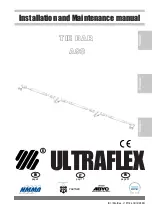
6
English
STERILE. Sterilized with ethylene oxide gas. Nonpyrogenic. For single use only. Do not resterilize.
Caution:
Federal (USA) law restricts this device to sale by or on the order of a physician.
I.
Components/Description
The
RAILWAY
™
Sheathless Access System
is a sheathless radial access system compatible with 5F, 6F and 7F Guiding Catheters of lengths 90 cm and 100 cm. The system consists of a 0.021”
guidewire compatible vessel dilator, a 0.035” guidewire compatible vessel dilator, a 0.021” mini-guidewire, an IV catheter (consisting of an IV cannula and a needle), and a bare needle. For catalog
codes where the 0.021” mini-guidewire is hydrophilic, the bare needle is not included.
Note:
The dilator size must match the guidewire and guiding catheter sizes. Refer to
Table 1
and to the product labeling for recommended guidewire and guiding catheter compatibility
information.
Table 1: Product Matrix and Recommended Compatibilities
Catalog Code
Wire
Vessel Dilator
Recommended Guiding Catheter
Compatibility
1
(and Inner Diameter)
Guidewire Compatibility
(2 Dilators)
Dilator Outer Diameter
Dimensions
RW5ADTH
Hydrophilic
5F, Gray
5F Cordis ADROIT
®
(0.058”)
0.021” and 0.035”
0.057” / 1.45mm
RW5ADTB
Bare
RW5VBTH
Hydrophilic
5F Cordis VISTA BRITE TIP
®
(0.056”)
0.021” and 0.035”
0.056” / 1.41mm
RW5VBTB
Bare
RW6ADTH
Hydrophilic
6F, Green
6F Cordis ADROIT
®
(0.072”)
0.021” and 0.035”
0.071” / 1.80mm
RW6ADTB
Bare
RW6VBTH
Hydrophilic
6F Cordis VISTA BRITE TIP
®
(0.070”)
0.021” and 0.035”
0.070” / 1.77mm
RW6VBTB
Bare
RW7VBTH
Hydrophilic
7F, Orange
7F Cordis VISTA BRITE TIP
®
(0.078”)
0.021” and 0.035”
0.078” / 1.97mm
RW7VBTB
Bare
1
For Guiding Catheter compatibility: Dilators have been optimized to fit either the Cordis VISTA BRITE TIP
®
or Cordis ADROIT
®
catheters (as listed in
Table 1
), and have not been dimensionally optimized for
compatibility with other guiding catheters. Refer to dimensions in
Table 1
.
Vessel Dilators
The vessel dilators have a lubricious hydrophilic coating and facilitate the percutaneous entry of a guiding catheter by forming a smooth, atraumatic transition from the skin through the
subcutaneous tissue and into the vessel. Refer to
Figure 1
for dilator details.
The hydrophilic coating covers the distal 20 cm of the vessel dilator. The hydrophilic coating must be activated by soaking the distal end of the vessel dilator in saline prior to using the dilator. Refer to the Preparation section
for device preparation instructions.
A wire port near the distal end is designed to enable easy removal of the mini-guidewire. Refer to
Table 1
for guidewire compatibility information.
Both vessel dilators have two proximal markers, labeled A and B in
Figure 1
. Marker A (the more proximal marker) is used as a position reference when using a compatible 100 cm guiding catheter. Marker B (the more
distal marker) is used as a position reference when using a compatible 90 cm guiding catheter.
IV Catheter Needle
An Introcan Safety
®
IV Catheter* access needle 3.2 cm is provided to facilitate initial entry into the artery. Removal of the needle leaves the IV cannula in place to facilitate insertion of the mini-
guidewire into the target vessel. Refer to
Figure 2
for IV Catheter details. Flush the needle per the Preparation section. Note that this needle contains chrome-nickel steel, and should not be used in
patients in which this may cause an allergic response.
Bare Needle
A bare access needle 3.8 cm is provided as an alternative to the IV catheter needle. It also facilitates initial entry into the artery. After initial entry of the bare needle into the target vessel the
mini-guidewire can be placed through the hub of the needle. Refer to
Figure 3
for bare needle details. Flush the needle per the Preparation section.
Note:
For catalog codes where the 0.021”
mini-guidewire is hydrophilic, the bare needle is not included.
Mini-Guidewire
A 0.021” diameter, 45 cm long mini-guidewire is provided for establishing vessel access. Refer to
Figure 4
for mini-guidewire details. The mini-guidewire is either bare or hydrophilic coated,
depending on the kit configuration.
Table 1
lists the type of wire included in each kit. Note that the hydrophilic coated wire contains nickel, and should not be used in patients in which this may
cause an allergic response.
II.
Indications
The
RAILWAY
™
Sheathless Access System
is indicated for use in radial arterial procedures requiring percutaneous introduction of intravascular devices.
III.
Contraindications
Avoid the use of the
RAILWAY
™
Sheathless Access System
in vasculature with extreme tortuosity, calcified plaque or thrombus.
Radial access is contraindicated in patients with:
•
Inadequate circulation to the extremity as evidenced by signs of artery occlusion or absence of radial pulse.
•
Hemodialysis shunt, graft or arterio-venous fistula involving the upper extremity vasculature.
IV.
Warnings
•
Prior to radial access procedures, it is recommended to verify adequate collateral flow through the ulnar artery, such as with an Allen test. If collateral blood supply to the hand is considered
inadequate, an alternate access site should be considered.
•
Do not use Ethiodol or Lipiodol** contrast media, or other such contrast media which incorporates components of these agents, as solvents used in these media may have a deleterious
effect on the device.
•
For the Introcan Safety
®
IV Catheter* needle, do not reinsert the needle into the IV catheter at any time. The needle could damage the IV catheter, resulting in an IV catheter embolus.
•
If using a hydrophilic wire, do not use with a bare needle or metal torque device, as this may damage the integrity of the coating.
•
Use of alcohol, antiseptic solutions, or other solvents should be avoided, as they may adversely affect the device.
•
Manipulate the mini-guidewire slowly and carefully to avoid damage to the vessel wall, while monitoring tip position and movement under fluoroscopy.
•
Failure to follow the procedural steps when exchanging a guiding catheter may result in loss of vessel access.
•
Do not manually re-shape the distal tip of the dilator or the mini-guidewire by applying external force intended to bend or affect the shape of the dilator or mini-guidewire.
•
The dilator must only be advanced while over a guidewire. Advancing the dilator without a wire in place may cause vascular complications.
•
Persons with allergic reactions to nickel may suffer an allergic response to components of this device.
Risk of re-use
This product is designed and intended for single use. It is not designed to undergo reprocessing and resterilization after initial use. Reuse of this product, including after reprocessing and/or
resterilization, may cause a loss of structural integrity which could lead to a failure of the device to perform as intended and may lead to a loss of critical labeling / use information all of which
present a potential risk to patient safety.
V.
Precautions
•
This product is intended for use by professionals who have been trained to perform coronary diagnostic and interventional procedures.
•
This product is intended to be used under fluoroscopic guidance.
•
Use the product immediately after opening the package.
•
Store in a cool, dark, dry place.
•
Prior to use, confirm that the vessel dilator size is appropriate for the access vessel, guiding catheter and with any other accessories to be used.
•
The entire procedure, from skin stick to product removal, must be performed aseptically.
•
Do not use if package is open or damaged.
•
Do not alter this product.
•
Use prior to “Use By” date.
•
This product is intended for radial arterial access and tracking up to, but not beyond, the subclavian artery only. No data has been collected to demonstrate the safety and effectiveness of
this product for use as a diagnostic or interventional device.
•
If the device becomes kinked or increased resistance is felt upon insertion or advancement of the vessel dilator, investigate the cause before continuing. If the cause of the resistance cannot
be determined and corrected, discontinue the procedure and withdraw the vessel dilator.
•
If increased resistance is felt upon withdrawal of the vessel dilator, investigate the cause before continuing, as excessive force during vessel dilator withdrawal can cause product damage or
vascular complications.
•
During the procedure, provide a proper anticoagulant or antiplatelet therapy to the patient.
VI.
Complications
Possible complications include, but are not limited to:
•
Abrupt vessel closure
•
Additional intervention
•
Allergic reaction (device, contrast medium and medications)
•
Amputation
•
Arrhythmia
•
Arteriovenous fistula
•
Death
•
Embolism
•
Fever
•
Hematoma at puncture site
•
Hemorrhage
•
Inflammation / Infection / Sepsis
•
Ischemia
•
Myocardial infarction
•
Necrosis
•
Peripheral nerve injury
•
Pain
•
Renal failure
•
Stroke
•
Transient ischemic attack
•
Thrombosis
•
Vascular complications (e.g. intimal tear, dissection, pseudoaneurysm, perforation, rupture, spasm, occlusion)
PPE Specification
Labeling Specification
Spec for Railway IFU
100322810 | Rev:4
Released: 09 May 2018
CO: 100510027
Release Level: 4. Production







































